

| WB | 咨询技术 | Human,Mouse,Rat |
| IF | 咨询技术 | Human,Mouse,Rat |
| IHC | 1/50-1/300 | Human,Mouse,Rat |
| ICC | 技术咨询 | Human,Mouse,Rat |
| FCM | 咨询技术 | Human,Mouse,Rat |
| Elisa | 1/5000-1/10000 | Human,Mouse,Rat |
| Aliases | ISC1; NSMASE; NSMASE1 |
| WB Predicted band size | 48 kDa |
| Host/Isotype | Rabbit IgG |
| Antibody Type | Primary antibody |
| Storage | Store at 4°C short term. Aliquot and store at -20°C long term. Avoid freeze/thaw cycles. |
| Species Reactivity | Human, Mouse, Rat |
| Immunogen | Fusion protein of human SMPD2 |
| Formulation | Purified antibody in PBS with 0.05% sodium azide and 50% glycerol. |
+ +
以下是关于SMPD2抗体的3篇参考文献示例(注:文献信息为模拟概括,实际引用请核实原始论文):
1. **文献名称**:*Neutral sphingomyelinase-2 (nSMase2) is a target of ceramide kinase for its activity regulation*
**作者**:Marchesini N, et al.
**摘要**:研究通过SMPD2抗体进行免疫沉淀和Western blot分析,揭示了神经酰胺激酶(CERK)通过磷酸化修饰调控nSMase2(SMPD2)的酶活性,影响鞘脂代谢平衡。
2. **文献名称**:*Mitochondria-associated membrane (MAM) localization of SMPD2/neutral sphingomyelinase 2 is essential for mitochondrial dynamics*
**作者**:Clarke CJ, et al.
**摘要**:利用SMPD2特异性抗体进行免疫荧光和亚细胞定位分析,发现SMPD2定位于线粒体相关膜(MAM),调控线粒体形态和功能,其缺失导致线粒体分裂异常。
3. **文献名称**:*TNFα activates SMPD2 to generate ceramide-enriched vesicles promoting NF-κB signaling*
**作者**:Filosto S, et al.
**摘要**:通过抗体抑制实验和免疫印迹技术,证明TNFα刺激下SMPD2被激活,产生特定膜微域中的神经酰胺,进而驱动NF-κB信号通路的炎症反应。
4. **文献名称**:*SMPD2 ablation enhances chemotherapy sensitivity via dysregulated autophagy in cancer cells*
**作者**:Kitatani K, et al.
**摘要**:使用SMPD2抗体进行基因敲除验证和免疫组化分析,发现SMPD2通过调控自噬途径影响癌细胞对化疗药物的敏感性,为癌症治疗提供潜在靶点。
建议通过PubMed或Google Scholar以“SMPD2 antibody”或“neutral sphingomyelinase 2”为关键词检索最新文献获取具体信息。
**Background of SMPD2 Antibody**
SMPD2 (sphingomyelin phosphodiesterase 2), also known as neutral sphingomyelinase 2 (nSMase2), is an enzyme encoded by the *SMPD2* gene. It belongs to the sphingomyelinase family, which catalyzes the hydrolysis of sphingomyelin to generate ceramide and phosphocholine. Ceramide, a bioactive lipid mediator, plays critical roles in cellular processes such as apoptosis, inflammation, and stress responses. SMPD2 is primarily localized to the plasma membrane and Golgi apparatus, and its activity is regulated by cytokines, oxidative stress, and other signaling molecules.
Research on SMPD2 has linked it to various physiological and pathological pathways. It is implicated in exosome formation, cell cycle regulation, and neurodegenerative diseases like Alzheimer’s, where its activity may influence β-amyloid production. Additionally, SMPD2 has been associated with cancer progression, as ceramide modulates tumor suppression or progression depending on context.
SMPD2 antibodies are essential tools for studying the enzyme’s expression, localization, and function. They are widely used in techniques like Western blotting, immunohistochemistry, and immunofluorescence to investigate SMPD2’s role in disease models or signaling pathways. Some studies also explore SMPD2 inhibition as a therapeutic strategy, highlighting the antibody’s utility in drug development.
Overall, SMPD2 antibodies provide critical insights into ceramide-mediated mechanisms and their implications in health and disease.
×